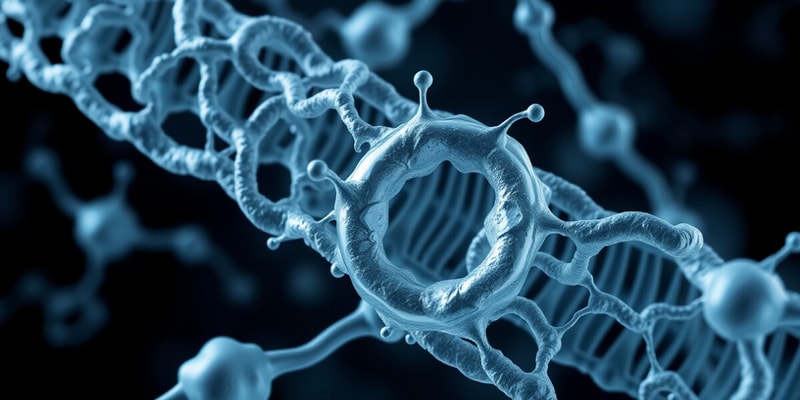Questions and Answers
What characteristic of phospholipids allows them to spontaneously form a bilayer in an aqueous environment?
In the fluid mosaic model, what do the 'islands of protein' represent?
Which type of membrane protein is characterized by being embedded within the lipid bilayer?
What is a significant difference between the outer mitochondrial membrane and the inner mitochondrial membrane?
Signup and view all the answers
What does it mean for lipid bilayers to be asymmetrical?
Signup and view all the answers
Which lipid is predominant in the outer mitochondrial membrane?
Signup and view all the answers
How do membrane proteins primarily assist in the function of cellular membranes?
Signup and view all the answers
What is the primary function of cholesterol within cellular membranes?
Signup and view all the answers
What role do glycoproteins play in cell membranes?
Signup and view all the answers
What is indicated by an abnormal metabolism of membrane components?
Signup and view all the answers
What effect does an increase in short chain fatty acids have on membrane fluidity?
Signup and view all the answers
Which of the following correctly describes lipid rafts?
Signup and view all the answers
What role does cholesterol play in the lipid bilayer?
Signup and view all the answers
Which type of membrane protein is primarily associated with cell-cell contact?
Signup and view all the answers
What characteristic defines integral (intrinsic) membrane proteins?
Signup and view all the answers
Which of the following statements about unsaturated fatty acids is true?
Signup and view all the answers
What is the primary function of transporters in the membrane?
Signup and view all the answers
Which type of membrane protein is involved in catalysis?
Signup and view all the answers
Which type of membrane protein is covalently linked to fatty acid chains?
Signup and view all the answers
What type of interactions do peripheral proteins use to attach to the membrane?
Signup and view all the answers
Which treatment will remove both peripheral and anchored proteins, but not integral proteins?
Signup and view all the answers
Phospholipase A2 selectively acts on which position of the phospholipid molecule?
Signup and view all the answers
Which of the following is an example of an anchored protein?
Signup and view all the answers
What is the role of phospholipases in membrane biology?
Signup and view all the answers
Which of the following proteins attach to the polar head group of phospholipids?
Signup and view all the answers
Which type of phospholipase hydrolyzes at the sn-1 position?
Signup and view all the answers
Study Notes
Learning Outcomes
- Recognize major lipid structures: saturated and unsaturated fatty acids, triacylglycerols, phospholipids, glycolipids, and cholesterol.
- Understand the fluid mosaic model depicting membranes as "islands of protein in a sea of lipid."
- Describe the biochemical components of membranes, including their orientation.
- Identify characteristics of membrane proteins: integral, anchored, and peripheral.
- Analyze membrane proteins using various methods.
- Appreciate the implications of abnormal lipid metabolism in diseases.
Membranes of a Cell
- Phospholipids are fundamental components; they self-assemble into bilayers in aqueous environments.
- Each phospholipid has a polar head group linked to glycerol via a phosphate group and two fatty acyl chains attached by ester bonds.
- Phospholipids are amphipathic, possessing both polar and non-polar regions.
Fluid Mosaic Model
- Represents membranes as composed of proteins embedded in phospholipid bilayers.
- Emphasizes dynamic nature with a mix of lipids and proteins.
Variation in Membrane Composition
- Different types of membranes (plasma, outer mitochondrial, inner mitochondrial, nuclear) have distinct lipid and protein compositions.
- Percentages of carbohydrates, protein-to-lipid ratios, and types of lipids (PC, PE, SPH, cholesterol) vary significantly across different membranes.
Lipid Bilayer Asymmetry
- The composition of the two halves of the bilayer differs: phosphatidylcholine (PC) and sphingomyelin (SPH) are found on the extracellular side; phosphatidylserine (PS) and phosphatidylethanolamine (PE) face the cytosolic side.
Membrane Fluidity
- Defined by the mobility of lipid molecules within the bilayer, essential for membrane functions like protein movement and signaling.
Regulation of Membrane Fluidity
- Fluidity is influenced by lipid composition: shorter fatty acid chains increase fluidity; unsaturated fatty acids create kinks that hinder tight packing.
- High cholesterol levels can reduce fluidity, leading to more ordered regions (lipid rafts).
Lipid Rafts
- Specialized microdomains in membranes that are more ordered and less fluid, containing higher cholesterol and sphingolipid levels.
- Facilitate interactions between receptors and signaling molecules.
Types of Membrane Proteins
- Structural Proteins: Facilitate cell adhesion and cytoskeletal attachment (e.g., actin, spectrin).
- Receptors: Involved in signal recognition and transmission (e.g., insulin receptor).
- Ion Channels: Maintain ionic gradients (e.g., GABAA receptor).
- Transporters: Mediate substrate transport (e.g., glucose transporters).
- Enzymes: Catalyze biochemical reactions (e.g., adenylate cyclase).
Organization of Membrane Proteins
- Integral proteins span the bilayer with transmembrane regions often forming alpha-helices or beta-sheets.
- Anchored proteins are covalently linked to fatty acids, positioned on the surface or attached via glycolipids.
- Peripheral proteins interact with the membrane surface through ionic interactions.
Protein Removal Methods
- High Salt/Urea: Removes peripheral proteins, but does not affect anchored or integral proteins.
- Detergents: Remove all types of proteins.
- Phospholipases: Can remove or retain proteins based on their nature.
Phospholipases
- Enzymes that hydrolyze phospholipid components; types include PLA1, PLA2, PLC, and PLD, each with specific targets in the membrane structure.
Summary Points
- Membrane structure is defined by the fluid mosaic model showcasing lipid and protein interactions.
- The distinct composition and fluidity of membranes influence functionality.
- Membrane proteins play crucial roles in cell interactions and metabolic processes.
Studying That Suits You
Use AI to generate personalized quizzes and flashcards to suit your learning preferences.
Description
This quiz covers essential concepts of cell membranes, including key lipid structures such as phospholipids, fatty acids, and cholesterol. It also delves into the fluid mosaic model of membranes and the characteristics of membrane proteins. Test your understanding of lipid metabolism and its impact on diseases.




